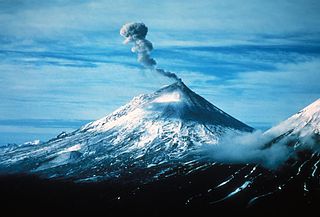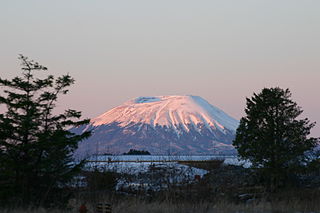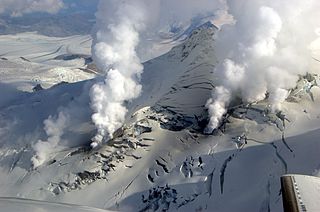Related Research Articles
A volcano observatory is an institution that conducts research and monitoring of a volcano.

The Yellowstone Caldera, sometimes referred to as the Yellowstone Supervolcano, is a volcanic caldera and supervolcano in Yellowstone National Park in the Western United States. The caldera and most of the park are located in the northwest corner of Wyoming. The caldera measures 43 by 28 miles, and postcaldera lavas spill out a significant distance beyond the caldera proper.

Redoubt Volcano, or Mount Redoubt, is an active stratovolcano in the largely volcanic Aleutian Range of the U.S. state of Alaska. Located at the head of the Chigmit Mountains subrange in Lake Clark National Park and Preserve, the mountain is just west of Cook Inlet, in the Kenai Peninsula Borough about 110 miles (180 km) southwest of Anchorage. At 10,197 feet (3,108 m), in just over 5 miles (8.0 km) Mount Redoubt attains 9,150 feet (2,790 m) of prominence over its surrounding terrain. It is the highest summit in the Aleutian Range. In 1976, Redoubt Volcano was designated as a National Natural Landmark by the National Park Service.
In October 2006, the United States Geological Survey (USGS) adopted a nationwide alert system for characterizing the level of unrest and eruptive activity at volcanoes. The system is now used by the Alaska Volcano Observatory, the California Volcano Observatory, the Cascades Volcano Observatory, the Hawaiian Volcano Observatory and the Yellowstone Volcano Observatory.

Pavlof Volcano is a stratovolcano of the Aleutian Range on the Alaska Peninsula. It has been one of the most active volcanoes in the United States since 1980, with eruptions recorded in 1980, 1981, 1983, 1986–1988, 1996–1997, 2007, 2013, twice in 2014, 2016, and is currently erupting as of August 2021. Basaltic andesite with SiO2 around 53% is the most common lava type. The volcano is monitored by the Alaska Volcano Observatory- a joint program of the United States Geological Survey (USGS), the Geophysical Institute of the University of Alaska Fairbanks (UAFGI), and the State of Alaska Division of Geological and Geophysical Surveys (ADGGS). With a threat score of 95, the threat from future eruptions is considered to be high; much of this threat comes from the possibility of disruption of nearby air routes by large releases of ash. The mountain currently has basic real-time monitoring, but the USGS would like to improve instrumentation at the site. The mountain shares a name with the nearby Pavlof Sister, which last erupted in 1786.

Mount Edgecumbe is located at the southern end of Kruzof Island, Alaska, about 15 miles (24 km) west of Sitka. The dormant volcano is about 9.9 miles (16 km) east of the Queen Charlotte Fault that separates the North American and Pacific Plates, and is the highest point in the Mount Edgecumbe volcanic field, an area of about 100 square miles (260 km2) on Kruzof Island that also includes Crater Ridge and Shell Mountain.

Fourpeaked Mountain, also known as Fourpeaked Volcano, is an active stratovolcano located in the U.S. state of Alaska within Katmai National Park & Preserve. The volcano is nearly completely covered by Fourpeaked Glacier.

The Alaska Volcano Observatory (AVO) is a joint program of the United States Geological Survey (USGS), the Geophysical Institute of the University of Alaska Fairbanks (UAFGI), and the State of Alaska Division of Geological and Geophysical Surveys (ADGGS). AVO was formed in 1988, and uses federal, state, and university resources to monitor and study Alaska's volcanology, hazardous volcanoes, to predict and record eruptive activity, and to mitigate volcanic hazards to life and property. The Observatory website allows users to monitor active volcanoes, with seismographs and webcameras that update regularly. AVO now monitors more than 20 volcanoes in Cook Inlet, which is close to Alaskan population centers, and the Aleutian Arc due to the hazard that plumes of ash pose to aviation.
The Puff model is a volcanic ash tracking model developed at the University of Alaska Fairbanks. It requires windfield data on a geographic grid covering the area over which ash may be dispersed. Representative ash particles are initiated at the volcano's location and then allowed to advect, diffuse, and settle within the atmosphere. The location of the particles at any time after the eruption can be viewed using the post-processing software included with the model. Output data is in netCDF format and can also be viewed with a variety of software.

The California Volcano Observatory (CalVO) is the volcano observatory that monitors the volcanic and geologic activity of California and Nevada. It is a part of the Volcano Hazards Program of the United States Geological Survey, a scientific agency of the United States government.

The Yellowstone Volcano Observatory (YVO) is a volcano observatory that primarily monitors the Yellowstone Caldera in Yellowstone National Park in the United States. The observatory's jurisdiction also includes volcanic centers in the states of Colorado, Utah, Arizona, and New Mexico. As with other U.S. volcano observatories, it is funded through the United States Geological Survey Volcano Hazards Program.
The National Volcano Early Warning and Monitoring System is a U.S. federal program within the U.S. Geological Survey for monitoring volcano activity and providing early warning to threatened areas. It was authorized by the John D. Dingell, Jr. Conservation, Management, and Recreation Act on March 12, 2019.

Christina A. Neal is an American volcanologist and an honoree for a Samuel J. Heyman Service to America Medal. Neal was the Scientist-in-Charge at the Hawaiian Volcano Observatory from 2015 to 2020. Neal took over as the director of the U.S. Geological Survey (USGS) Volcano Science Center on May 9, 2021. Neal is a Fellow of the Geological Society of America.
Edward Wesley Hildreth III, is an American field geologist and volcanologist employed by the United States Geological Survey (USGS). He is a fellow of both the Geological Society of America (GSA), and the American Geophysical Union (AGU). Hildreth was described as "one of the great volcanologists/petrologists of our time" in the magazine Wired.

Judith Ellen Fierstein is a geologist and researcher employed by the U.S. Geological Survey (USGS). She is affiliated with the USGS California Volcano Observatory.

Michelle Lynn Coombs is a geologist at the Alaska Volcano Observatory (AVO). She was the Scientist-in-Charge from 2016 to 2023. Coombs is a fellow of the Geological Society of America.

James Gregory Moore is a geologist and winner of the 2020 Penrose Medal. Moore is a Scientist Emeritus for the U.S. Geological Survey.

Kenneth Hon, usually known professionally as Ken Hon, is a geologist and the 21st Scientist-in-Charge (SIC) of the Hawaiian Volcano Observatory (HVO), serving since 2021; succeeding Tina Neal (SIC) and David Phillips. Hon has often been a contact from the Observatory to the news media, and as such is often quoted as an authority figure in the field of Hawaiian volcanology.

James Puupai Kauahikaua is a geophysicist and volcanologist who served as the 19th Scientist-in-Charge of the Hawaiian Volcano Observatory from October 2004 to March 2015. He was the first Scientist-in-Charge at the Observatory to be of Hawaiian ancestry.
References
- ↑ National Research Council (June 16, 2000). "Appendix B". Review of the U.S. Geological Survey's Volcano Hazards Program. Washington, DC: The National Academies Press. doi:10.17226/9884. ISBN 978-0-309-17175-5.
- ↑ "tkeith: Terry Keith". Southern California Earthquake Center. Retrieved April 14, 2023.
- 1 2 Klemetti, Erik (March 27, 2023). "The Changing Face of Volcanology". Discover Magazine . Retrieved April 7, 2023.
- ↑ Klemetti, Erik (March 29, 2023). "A Long Way Still to Go to Create Representative Volcanology". Discover Magazine . Retrieved April 7, 2023.
- ↑ Examples include:
- "Stuck robot may get some human help". Tampa Bay Times . August 9, 1994.
- "Residents Leave as Aleutian Volcano Rumbles to Life". Los Angeles Times . Anchorage. Associated Press. March 17, 1996.
- "Alaskan Volcano Erupts in a Plume of Ash". The New York Times . Associated Press. December 12, 1996. ISSN 0362-4331.
- ↑ "Inside USGS, No. 2, Patrick Muffler, Yellowstone". U.S. Geological Survey . Retrieved April 14, 2023.
- ↑ White, Donald Edward; Hutchinson, Roderick A.; Keith, Terry E. C. (1988). "The Geology and Remarkable Thermal Activity of Norris Geyser Basin, Yellowstone National Park, Wyoming". U.S. Geological Survey Professional Paper 1456. doi: 10.3133/pp1456 .